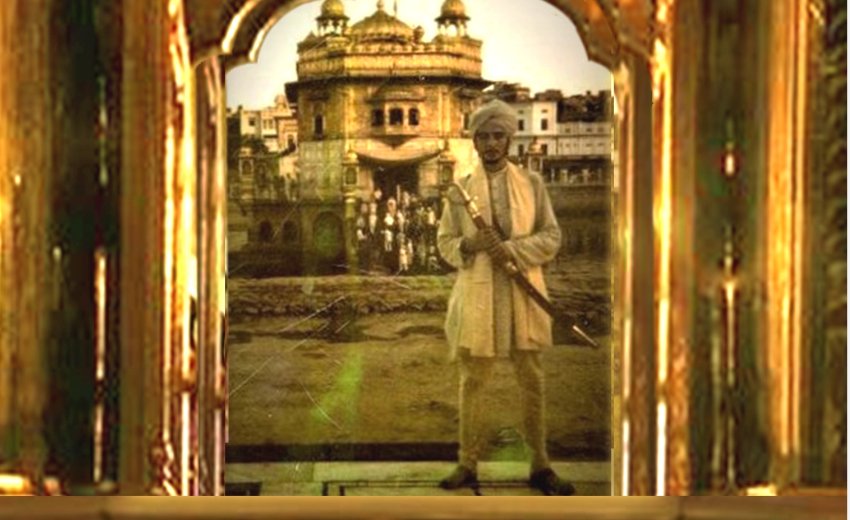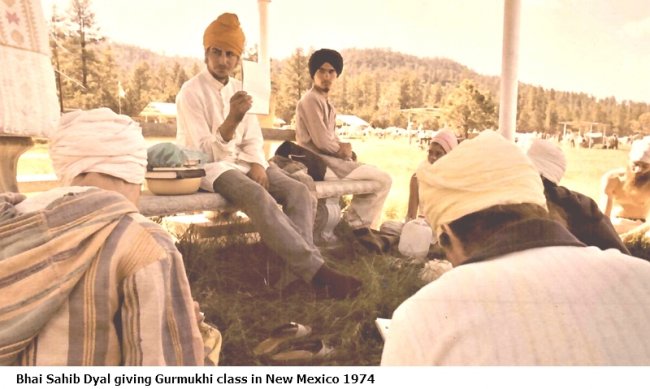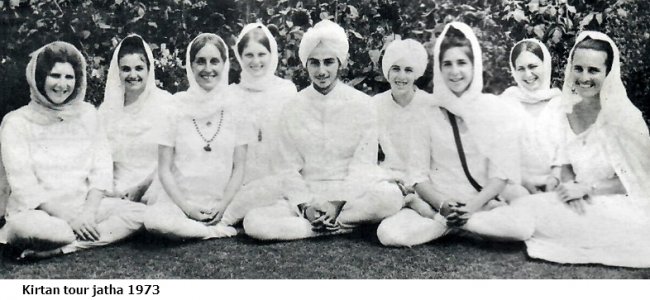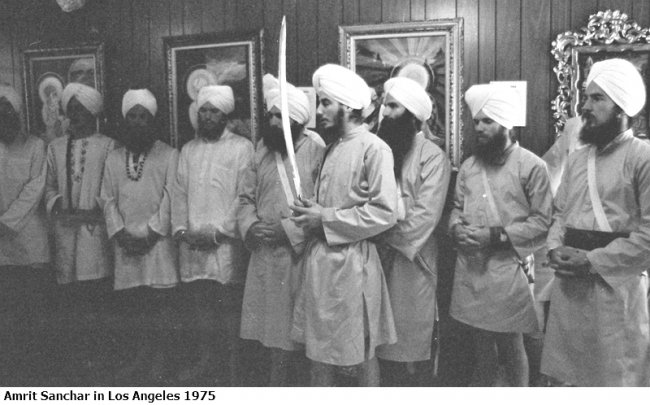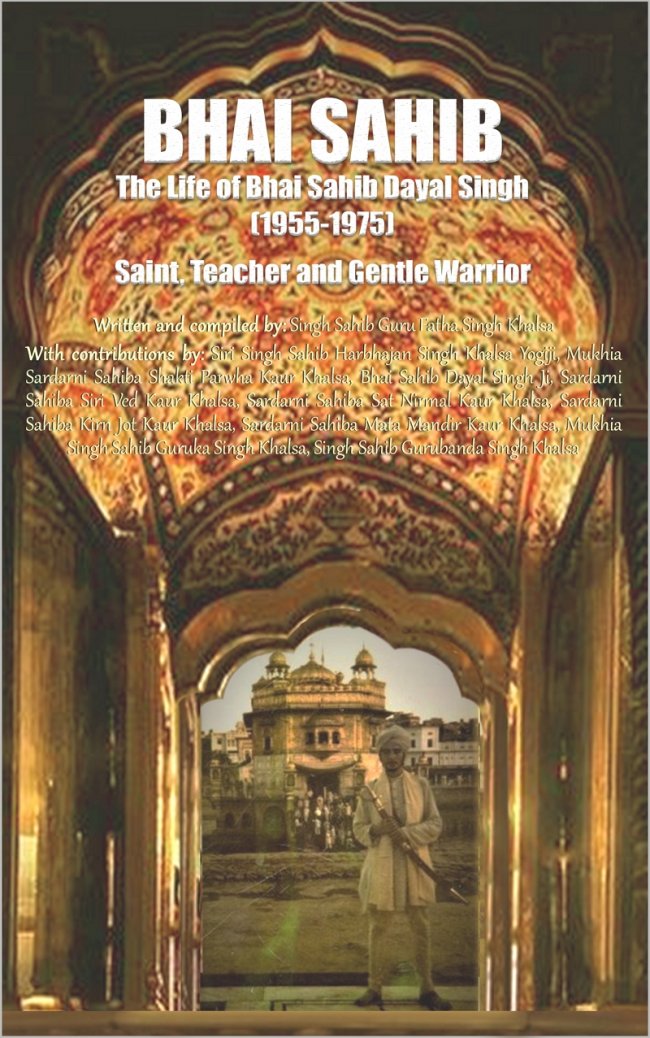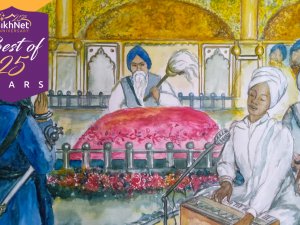When an Indian yoga teacher came to give a class at his Los Angeles high school in 1970, Dale Sklar recognized at once a calling from out of the ordinary. He quickly attached himself as a devoted student to Yogi Bhajan and the fledgling American Sikh community a few miles' bike ride from his home. For his sheer focus, love and devotion to his new path, Dale was recognized as "Bhai Sahib" - a religious title meaning honoured brother - "Dayal Singh" - a spiritual name meaning lion of compassion, before his 18th birthday.
Towering above fellow Sikhs many years his senior, Bhai Sahib lived an exemplary life of service and good humour until his passing a car crash - on the way to India - at the age of 19. This is his story told in the words of people who knew, loved and respected Dayal Singh, and in nearly 100 photos of his brief life as a Sikh in America and India in the early 1970s.
Selections - I
In the words of Bhai Sahib:
In 1970, at the age of fifteen, I began taking classes from Siri Singh Sahib Harbhajan Singh Yogi. In the yoga classes, he recommended that we not cut our hair or beards for scientific reasons.
He suggested that we read a book called The Sacred Writings of the Sikhs (a translation of selected parts of Guru Granth Sahib). He instructed us to recite Ik Ong Kar Sat Nam Siri Waheguru.
He also had us recite certain lines of Gurbaanee such as Jis Neech Ko Ko-ay Na Jaan-ai… Guru Raam Daas Raakho Sarna-ee… Gobinday Mukanday Udaaray Apaaray… as well as the Mool Mantra. He enjoined us to attend the once-a-month service at the Sikh Study Circle and he suggested that we learn Gurmukhee.
In the house of Siri Singh Sahib Ji, I began studying Gurmukhee. I had a great drive and in two days I could fully read. At that point, I began to read Guru Granth Sahib with corresponding translation. Gurbaanee became the focal point of my life…
II
For a month, they stayed in New Delhi, practising Keertan every day. Bibiji was always busy with one or another guest or arranging their coming tour. For his part, Dale Singh took every available opportunity to practice the local languages, Hindi and Punjabi.
At last, it was time to share what they had learned. They found their way to Gurdwara Damdama Sahib, a short walk away, where a congregation of a few thousand awaited them. The ladies, Ganga Kaur and Wilma Kaur at the harmonium and Sat Kirn Kaur on the guitar, performed the two Songs they had been practising every day. Then Dale Singh gave a little talk in English which was translated into Punjabi.
“Do not be surprised to see American Sikhs,” he said. “Within many of your lifetimes, you will see Sikhs from all countries. It is our prayer that they will live in the brotherhood of the Khalsa as Guru Sahib instructed. The Siri Guru Granth Sahib will be translated into every language of the world. We now have the scriptures with English translation next to the original Gurbaanee in corresponding numbered words and in this way, learn the meaning of Guru Sahib’s Word.”
III
Dale Singh was self-critical enough to recognize his own short-comings. He could also be inventive in overcoming them. During his visit to the home of Guru Amar Das in the town of Khadur Sahib, Punjab, Dale Singh had noticed a hook on the ceiling to which the Guru used to tie a rope attached to his topknot. Being aware of his own habit to nod in and out of awareness in the early morning hours, Dale Singh installed a hook in the ceiling over the place where he always sat during morning Sadhana, and tied his rishi knot to the hook on the ceiling with a cord.
IV
Dale Singh always served langar after Sunday Gurdwara. He did late-night clean-up at the restaurant as a service. Bhai Sahib volunteered for all Seva. He taught through his consistent example of what selfless service is.
Dale Singh never tolerated gossip. He neither spoke nor listened to it. If someone had some juicy morsel to share, he would say, “I don’t want to hear it,” and change the subject.
Bhai Sahib disliked asking anyone to volunteer for Seva in an Akhand Paath. He either worked with the few who loved to do it or did it himself. Dale Singh used to take turns for the 11pm to 3 am shifts in Los Angeles Akhand Paaths, but usually ended up reading most of it.
V
When Dayal Singh arrived back in Los Angeles, he took up the responsibility of taking care of the Gurdwara at Guru Ram Das Estate. The central obligation at the Gurdwara was to literally “reveal” Siri Guru Granth Sahib for the community early each morning and to return it to a “posture of ease” at the end of each day.
These routines, involved doing a prayer and respectfully unwrapping the Siri Guru, taking a Hukam and leaving it open for others to read in the morning. In the evening, there was another prayer, recitation of Keertan Sohila, a Hukam, then closing the Guru and putting it to bed for the night.
Though Dayal Singh’s home was five kilometers (three miles) away and he had no car, he eagerly accepted his new duties, and walked to the Gurdwara every morning before daylight and again in the evening.
Book Cover:
